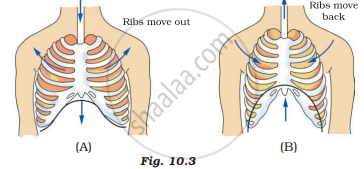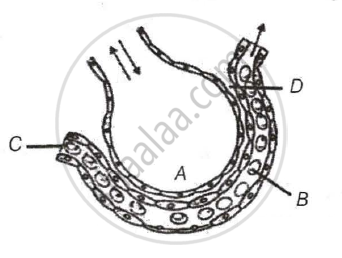Advertisements
Advertisements
प्रश्न
Distinguish between open circulation and closed circulation.
उत्तर
| Open circulation | Closed circulation | ||
| 1. | In open circulation, blood is circulated through the body cavities (haemocoels). | 1. | In closed circulation, blood circulates the blood vessels and does not come in direct contact with cells and body tissues. |
| 2. | The blood flows with low pressure. | 2. | The blood flows with high pressure. |
| 3. | Exchange of material takes place directly between blood and cells or tissues of the body. | 3. | Exchange of material between blood and body tissues is through intermediate fluid called lymph. |
| 4. | It usually does not contain any respiratory pigment like haemoglobin so it does not transport respiratory gases | 4. | It contains respiratory pigments like haemoglobin for transportation of respiratory gases. |
| 5. | e.g. Arthropods and molluscs | 5. | e.g. All vertebrates, higher molluscs and annelids |
APPEARS IN
संबंधित प्रश्न
Distinguish between photosynthesis and aerobic respiration.
Normal range of breathing rate per minute in an average adult person at rest is ______.
Write true or false for the following statement. Rewrite the false statement correctly.
Respiration and breathing are two different processes.
How is the process of respiration different from breathing?
Very short answer question.
Why is a gas exchange very rapid at the alveolar level?
Short answer question.
Why is it advantageous to breathe through the nose than through the mouth?
Give any two effects of carbon monoxide poisoning.
______ nerve is located at the end of the eyes behind the retina.
Differentiate between inhalation and exhalation.
The Tidal Volume of a normal person is ______.
Make the correct pairs.
| Column – I | Column – II |
| (P) Tidal volume | i. 1000 to 1100 ml |
| (Q) Residual volume | ii. 500 ml |
| (R) Expiratory reserve volume | iii. 2500 to 3000 ml |
| (S) Inspiratory reserve volume | iv. 1100 to 1200 ml |
For which of the following reasons stepwise cellular respiration is useful?
Identify the CORRECT statement.
During inspiration, the inter-costal muscles ____________.
Identify the role of NAD+ in cellular respiration
____________ in mammals do not help in respiration.
The impulse for voluntary muscles for forced breathing starts in ____________.
Observe the figures given in Figures 10.3 (A) and (B) and answer the following.
Which of the figures A or B indicates the process of inhalation and which is the process of exhalation?

The partial pressures (in mm Hg) of oxygen (O2) and carbon dioxide (CO2) at alveoli (the site of diffusion) are ______
Explain the mechanism of breathing with neat labelled sketches.
What is Dead Space?
Identify the wrong statement with reference to the transport of oxygen.
In Hamburger’s phenomenon, ______.
The figure given below shows a small part of human lung where exchange of gas takes place. In which one of the options given below, the one part A, B, C or D is correctly identified along with its function.

What is the vital capacity of our lungs?
What is oxygen dissociation curve?
